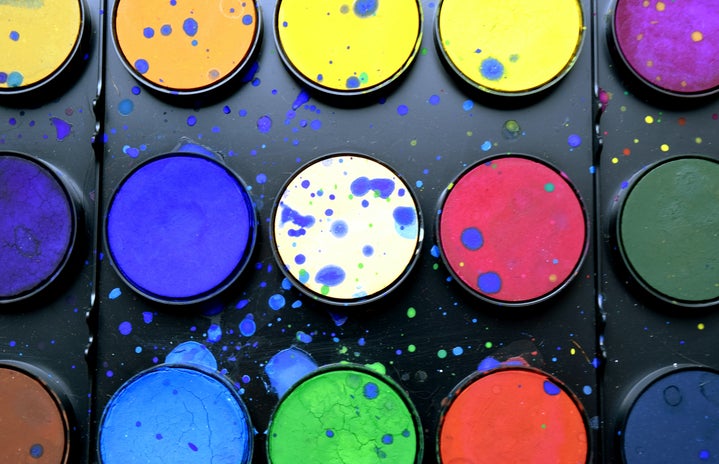When Gabriela Mejia and I sat down to meet about her chapbook (a short book of writing with a common theme or style throughout), I was supposed to be giving her feedback for her to work on the next draft of her project. Instead, I got so easily wrapped up in the work she was creating for not only our writing class but also her art history thesis. This led to a more formal interview.
HC: What are your majors/minors?
GM: I’m an art history major with a double minor in psychology and creative writing.
HC: What is your favorite art style to study?
GM: Ah, that’s a difficult question, considering how many art styles I’ve studied. I will say that I love learning about the Impressionists and Post-Impressionists. I do like how dramatic and bombastic Baroque Art is, and I also enjoy the absurdity of Dadaist art, a style that emerged after the chaos of World War I. Rococo art, which is a style that catered to the French nobility right before the French Revolution of 1789, is a guilty pleasure for me. It’s ridiculously filled with pastel colors and light, flouncy imagery, but still, I love it.
HC: What theses are you currently completing?
GM: Currently, I’m completing my art history thesis, as well as a Creative Writing Seminar.
HC: What is your art history thesis about?
GM: My art history thesis is focusing upon an Italian Baroque artist, Artemisia Gentileschi, and upon her two major works: Susanna and the Elders (1610) and Judith Slaying Holofernes (1620). In my thesis, I plan to examine Gentileschi and her paintings, making a claim that states that Gentileschi, like the heroines of her paintings, rises above the dichotomy of victimization and agency.
HC: What inspired you to pursue this?
GM: Gentileschi is an artist that has always fascinated me since I first learned about her in an AP Art History class in high school, so I thought that it would be an interesting venture to learn more about her and the development of her paintings in the midst of the Baroque period. Furthermore, it’s fascinating how she depicts her biblical heroines, as opposed to how male artists have depicted them. Once you do enough research about the Baroque period and how it was shaped by the humanistic thought of the Renaissance, you start to notice how there was a shift in depicting female characters, especially female biblical characters who were assertive in their actions. Male artists in general either sexualized these female biblical characters, or they satirized their actions by depicting them with disproportionate musculature. In contrast, Artemisia Gentileschi depicted her female characters as they were: un-idealized, non-sexualized, and arguably portrayed them more accurately in the contexts of their stories than previous male artists had.
HC: What does your creative writing project include?
GM: My creative writing project involves the creation and development of two chapbooks. So far, the first chapbook is titled, A Day at the Museum, and it contains a series of ekphrastic poems.
HC: How did you combine your art history and creative writing passions for this project?
GM: For A Day at the Museum, I decided to use ekphrastic poems. Ekphrastic poems are often vivid descriptions of scenes or works of art. I wanted my first chapbook to be a merging of the two disciplines of art history and creative writing. Considering that I have had experience in writing ekphrastic poetry, and in writing about and researching art, it was an enjoyable process to create poetry.
HC: Why did you decide to write about art?
GM: I think part of the reason why I wrote about art was due to visiting many art museums in the recent Paris J-Term trip, so the visits and the art were fresh on my mind. Also, I have always enjoyed art, and I’ve come to love learning about it, as well as the historical contexts behind their creation. So, I wanted to write about art creatively, rather than academically for a change.
HC: So the parallel was purposeful?
GM: I believe the parallel was purposeful. When writing creatively, I believe that the potential for inspiration can come from anywhere, and art is a good vehicle for this. For example, some of the more recent art pieces I wrote about, such as the art of Edward Hopper and Cindy Sherman, have inspired me to use different styles of poetry. With one of the poems inspired by Hopper, I wrote a poem that read and sounded more like prose; with a poem inspired by Sherman, I used a combination of prose poetry and a specific dialect that I thought would pertain to the art piece and the period it appears to take place in.
HC: Any ideas for what you’re going to write next?
GM: So far, I’ve been juggling around a few ideas for my next chapbook. One idea involved writing a series of flash fictions about misaligned women in fiction and mythology, such as Cassandra from The Oresteia or the Bride of Frankenstein’s monster. I’ve also considered doing a few retellings of folktales and myths from Latin America. Another idea I’ve pondered upon, is maybe writing a series of vignettes about a small town inspired by the podcast, Welcome to Night Vale. Nothing’s set in stone yet, so I’m still trying to work and formulate different ideas.
If the second chapbook is even half as interesting as the first one sounds, it’s going to turn out amazing! Good luck to Gaby as she finishes her senior year off strong.


